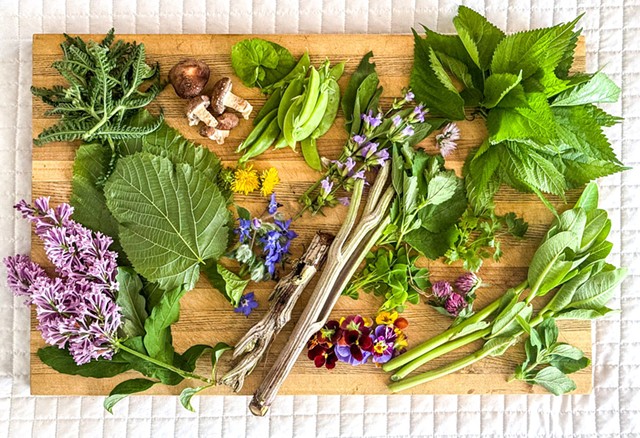
- Suzanne Podhaizer
- Wild and homegrown ingredients for lunch
When the leaves of the wild leek have withered and the fronds of fiddlehead ferns have unfurled, it's time to turn to the less sexy but equally delicious wild edibles that emerge in early summer. The woods and other green spaces still yield plentiful ingredients to toss into salads and tender shoots and stalks to add to stir-fries. It's also a wonderful moment to harvest wild and cultivated flowers that are edible as well as ornamental, such as roses, daylilies and pansies.
I have favorites that I gather near my home, such as a spicy little leaf called crinkleroot that grows in moist, slightly acidic soil in the woods; chickweed that peeks from between the lettuce plants in my garden; and the occasional bright orange chicken of the woods mushroom.
To broaden my horizons, I reached out to Serena Morgan of Newport, whom I knew only from the luscious-looking vegan creations she posts on the Vermont Foragers Facebook group.
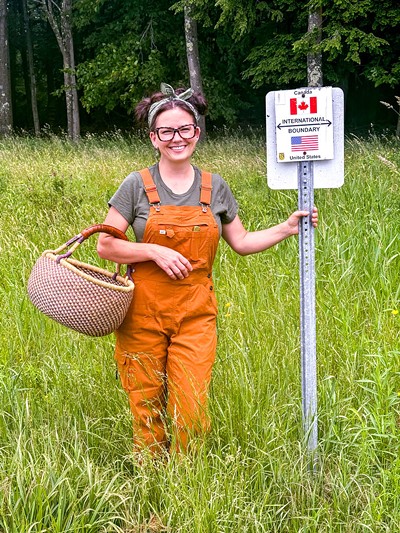
- Suzanne Podhaizer
- Serena Morgan at the Canadian border
The Newport native, 43, studied industrial design at New York City's Pratt Institute and is currently enrolled in an online herbalism program. Morgan makes a living producing jewelry that incorporates or mimics natural materials and products made from foods that she has harvested, fermented, brewed, dried and steeped. Under the name Serene Offerings of Vermont, she sells her wares online, on Saturdays at the Newport Farmers Market and at special events around the state.
I met Morgan at the home she shares with her fiancé, chef Bronson Lizares, whom she met working in the Vermont restaurant industry. She runs her business from their Main Street residence, complete with a gazebo the couple built and raised beds filled with vegetable starts.
The living space has no dedicated bedroom, but it does have an apothecary bursting with flower-infused honeys, dried herbs such as yarrow flowers and tulsi leaves, and jars of fire cider and four thieves vinegar. The latter concoction, made by steeping medicinal herbs in vinegar, supposedly helped light-fingered French folk safely ply their law-breaking trade during the plague. It is now used as a more general health booster.
From Morgan's home, we headed to one of her favorite walking trails, which brushes up against the Canadian border. There we found burdock, nettle and basswood leaves. Back in her tiny kitchen, we turned these treasures into a meal by adding wheat berries, homemade ramp-infused soy sauce and several types of Morgan's kimchi. We also used edible flowers and mustard and coriander seeds I had brought from my garden.
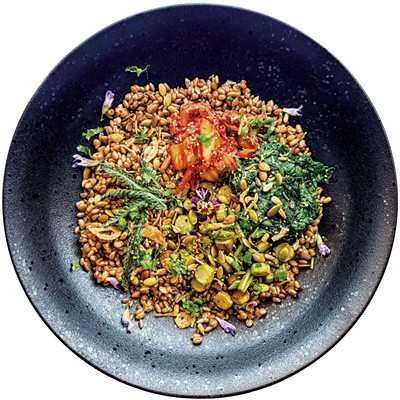
- Suzanne Podhaizer
- Grain bowl with nettle, burdock, flowers and kimchi
In the gazebo, we chatted about our favorite ways to prepare wild foods as we tucked into grain bowls topped with tender blanched nettles, sautéed burdock shoots, lightly bitter fresh yarrow leaves and sweet sage blossoms. We also ate young basswood leaves wrapped grape leaf-style around mushrooms and vegetables sprinkled with chive blossoms, borage flowers and dandelion petals.
Asked how often she eats foods she has harvested, Morgan said, "In spice and condiment form ... almost on the daily year-round." That's thanks to the products that she makes for herself and her customers, such as ramp ketchup, wild mushroom soy and an array of seasoned salts. She also drinks tea made of dried herbs and flowers.
In the warmer seasons, she adds her fresh finds, from spruce tips to apple blossoms to shaggy mane mushrooms.
Here's a primer on the wild components of our meal. An important disclaimer: Don't eat any part of any plant unless you're positive you know what it is. Some poisonous plants look extremely similar to nonpoisonous plants. Use guidebooks, apps and the internet for research. One of the best ways to learn about edible plants is to go out foraging with somebody who is knowledgeable and experienced.
Beyond the Burrs
Burdock, Arctium lappa
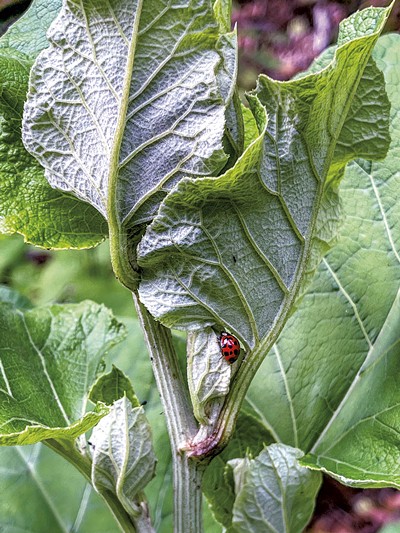
- Suzanne Podhaizer
- Burdock stalk and leaves
Most Vermonters' primary experience with burdock is one of frustration when its Velcro-like seedpods or burrs stick to fabric, hair and pets. They may not know that, throughout the growing season, nearly every part of the plant is at least temporarily edible.
In spring, young shoots and leaves can be boiled and consumed, although the leaves become quite bitter as they grow. In spring and fall, with significant effort, one can dig up the roots to use as a vegetable — referred to as gobo in Japan — or dry them for medicinal uses. In early summer, the immature flower stalks make a delicious vegetable, which tastes a little like burdock's relative artichoke.
I love to chop down burdock stems before the flowers emerge, peel and cut them, and simmer the slices in salted water for a couple minutes. From there, I drain the stalks and sauté them in a splash of olive oil if I'm going for Italian artichoke vibes or sesame oil if I'm making an Asian dish.
With the peeled roots, I also make a dish called kinpira gobo: matchstick slivers of burdock stir-fried and then simmered in a combination of water, tamari or soy sauce, mirin, sake, and sugar, with red chile flakes for a little heat. The pan should be almost dry by the time you're done cooking it.
Greek-Style Greens
Canadian wood nettle, Laportea canadensis; and stinging nettle, Urtica dioica

- Suzanne Podhaizer
- Canadian wood nettle tips
The first time I knowingly encountered stinging nettle was during a painful, bare-shinned hike on Addison County's Snake Mountain. As I cursed, it never occurred to me that I might want to harvest and eat the leaves of such a prickly plant.
Nowadays, I primarily harvest just the top few leaves of the less aggressively spiky Canadian wood nettle before it goes to flower. Both types of nettle are plentiful in Vermont, edible and believed to have medicinal properties, such as anti-inflammatory and antioxidant benefits.
To cook nettles, rinse them in cool water and then blanch them until they turn bright green, thus neutralizing their sting. To stop the cooking, immediately rinse them with very cold water. (Save the blanching liquid and drink it as a tea.) Now you can use them in any dish that calls for greens.
Morgan and I added blanched nettles to a grain bowl, but you can also make nettle soup with your favorite broth and a few squeezes of lemon, or cream the nettles like spinach. A traditional Greek dish called by many names — including plastos, pispilita and Epirotiki — sandwiches a combination of nettles, cooked onion and feta between layers of cornmeal batter.
Tree Treats
American basswood, Tilia americana
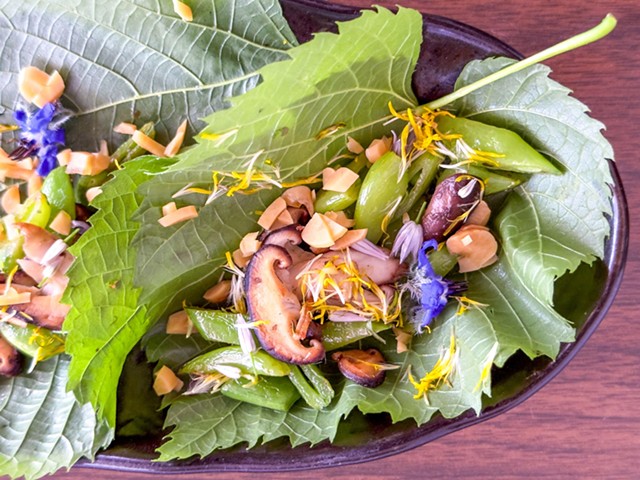
- Suzanne Podhaizer
- Basswood leaf rolls
The basswood is a surprising source of nourishment. The rough-barked trees with heart-shaped leaves yield buds that make an interesting trailside snack and intensely fragrant flowers that can be brewed into tea. After the tree flowers, its seeds can be eaten raw or cooked.
Morgan likes to use the young leaves as a salad green and the bigger, older leaves to make delicate wraps. At her house, we stuffed the raw leaves with a combination of cooked shiitake mushrooms and sugar snap peas, tossed with oil and slivers of Morgan's fermented garlic flavored with Korean gochujang chile paste.
Banquet of Blooms
Ornamental and wildflowers
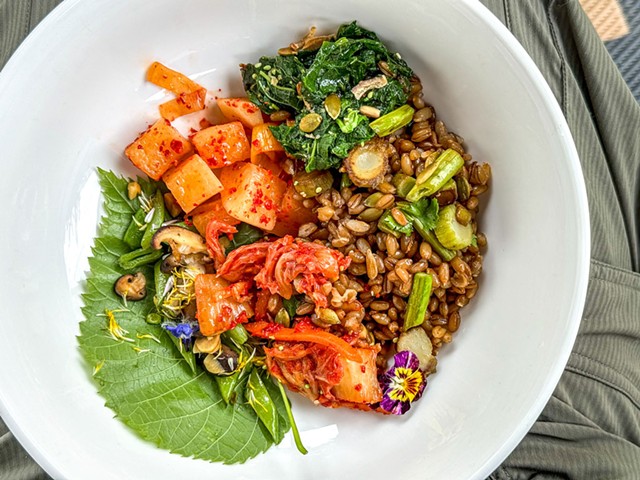
- Suzanne Podhaizer
- Suzanne's lunch plate
Many flowers that are grown for their showy blooms also happen to be edible, provided they're not sprayed with pesticides. Daylilies — not Asiatic lilies — can be eaten raw or cooked. Marigolds are great at protecting gardens from pests, and the petals give dishes a beautiful golden glow. Other edible cultivated and wild flowers include borage, calendula, violets, cornflower, nasturtium, peonies, clover, sunflower, and squash and chive blossoms.
Flower petals are beautiful in every part of a meal, from appetizers to desserts. Taste the flowers you're using and determine which foods they'll pair well with. I use sunny, peppery nasturtiums in salads and violets and pansies in veggie-and-pesto rolls that I wrap in translucent rice paper.
Although Morgan steeps herself in the pleasures of cooking and eating, for her, the search for wild edibles is more than a culinary pursuit. "The woods and fields have led me out of some dark, anxiety-filled times," she said, "and filled my life with the excitement of the 'you never know what you are going to find [variety]'."
Even when she leaves with an empty basket, Morgan said, "The one thing I always come out of the woods with is peace, calm and happiness."
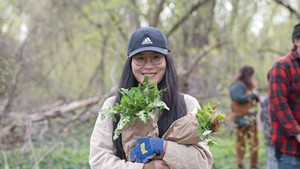






Comments
Comments are closed.
From 2014-2020, Seven Days allowed readers to comment on all stories posted on our website. While we've appreciated the suggestions and insights, right now Seven Days is prioritizing our core mission — producing high-quality, responsible local journalism — over moderating online debates between readers.
To criticize, correct or praise our reporting, please send us a letter to the editor or send us a tip. We’ll check it out and report the results.
Online comments may return when we have better tech tools for managing them. Thanks for reading.